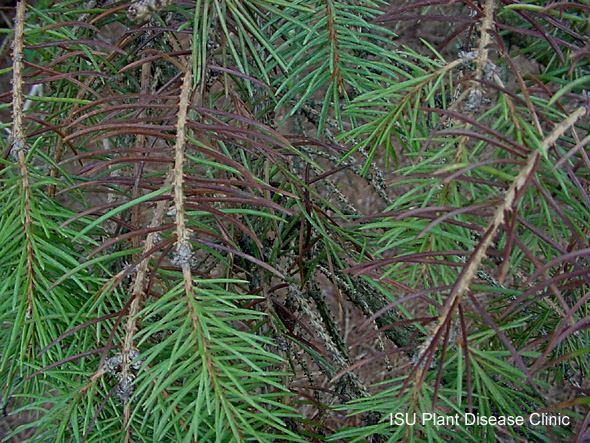Introduction
Rhizosphaera needle cast is a fungal disease that affects many spruce trees, particularly Colorado blue spruce, and Engelmann spruce. The causal agent of the disease is the fungus, Rhizosphaera kalkhoffi. Rhizosphaera needle cast was first observed in 1939. It was reported infecting Colorado blue spruce in Connecticut. Rhizosphaera needle cast is now regarded as one of the most common needle diseases to affect spruce trees.
Distribution & Habitat
Infections of Rhizosphaera needle cast occur frequently across the United States. The disease is particularly common in many northeastern and midwestern states, including Connecticut, New York, Massachusetts, Virginia, Pennsylvania, Wisconsin, Michigan, Minnesota, Idaho, Indiana, North Dakota, Arizona, and Colorado. Infections have also been documented throughout the Southern United States. In Canada, the disease ranges from Quebec to New Brunswick.
Hosts
Colorado blue spruce, and Engelmann spruce are highly susceptible to infection. Infections also occur on white spruce and Douglas-fir, albeit with less frequency. Norway spruce exhibits relative resistance to the disease. As such, it is rarely infected. Trees that are undergoing environmental stress, or are infested with insects are more prone to infection. Young trees, and saplings are most vulnerable to infection, though trees of all ages may be invaded by the pathogen.
Disease Cycle
The disease pathogen overwinters in needles on the host tree, or on needles that have been shed by the host tree. In spring, minute fruiting bodies called pycnidia reach maturity, and push through the stomata of the infected needles. During rainy periods, the pycnidia rupture, and release spores, which are splashed by the rain, or disseminated by air currents to nearby growth, where they initiate new infections. The spores infiltrate the stomata of healthy needles. They reside within the stomata for forty eight hours before germinating. Under less favorable conditions, the spores may require a longer germination period.
Once the fungus has infiltrated the stomata, it develops within the needle until the following year. During this period, the host may not exhibit symptoms of infection. In May, mature fruiting bodies will appear on the seemingly healthy needles. Throughout summer, the infected needles will turn yellow, then reddish-brown or purple by fall. This discoloration is conspicuous, particularly on Colorado blue spruce. Most infected needles are shed prematurely, though some may linger on the tree. Infections generally occur in spring, but first year needles are susceptible throughout the growing season. In areas where rainfall is consistent, infections may occur in August and September.
Symptoms of Infection
Infected spruce trees will only retain a single year of growth. Foliage on the inner branches, and on the lower portion of the crown is most susceptible to infection. When infections are severe, the lower branches will die back, and the disease will progress to the upper branches. In summer, the infected needles turn yellow. By fall, they deepen to reddish brown or purple. Trees that are sparse on the lower part of the crown, or only display a year or two of needle growth may be infected. The needles of symptomatic trees should be examined in early spring, prior to bud break. Black fruiting bodies may be observed in neat lines, along the length of the infected needles. Branches that are defoliated for three to four years will die back. This can cause the tree to develop a malformed appearance, reducing its ornamental value.
Management
- Plant spruce trees in locations that feature good drainage.
- When planting, select resistant varieties of spruce. Norway spruce, Black Hills spruce, and white spruce all exhibit an increased resistance to the disease pathogen. Trees that are grown from healthy nursing stock are ideal for planting. Avoid planting young spruce trees near older spruce trees that may be harboring the disease pathogen. Ensure that plants are afforded sufficient space to allow for proper air circulation.
- To limit the number of potential inoculum sites, eliminate weeds by periodically mowing the grass.
- Rake, and dispose of fallen needles to further reduce potential inoculum sites.
- Fungicide applications are effective at combating the disease. Initial applications should be performed when new shoots are ¾ of an inch to 1 ¼ inches long. Moderate to severe infections may require two additional applications at three week intervals.
- Maintain tree vigor through sound cultural practices. Ensure that trees are sufficiently watered, especially during extended periods of drought. Apply a layer of organic mulch around the base to improve soil quality, moderate soil temperature, and maintain soil moisture.
Photo courtesy of Iowa State University.


